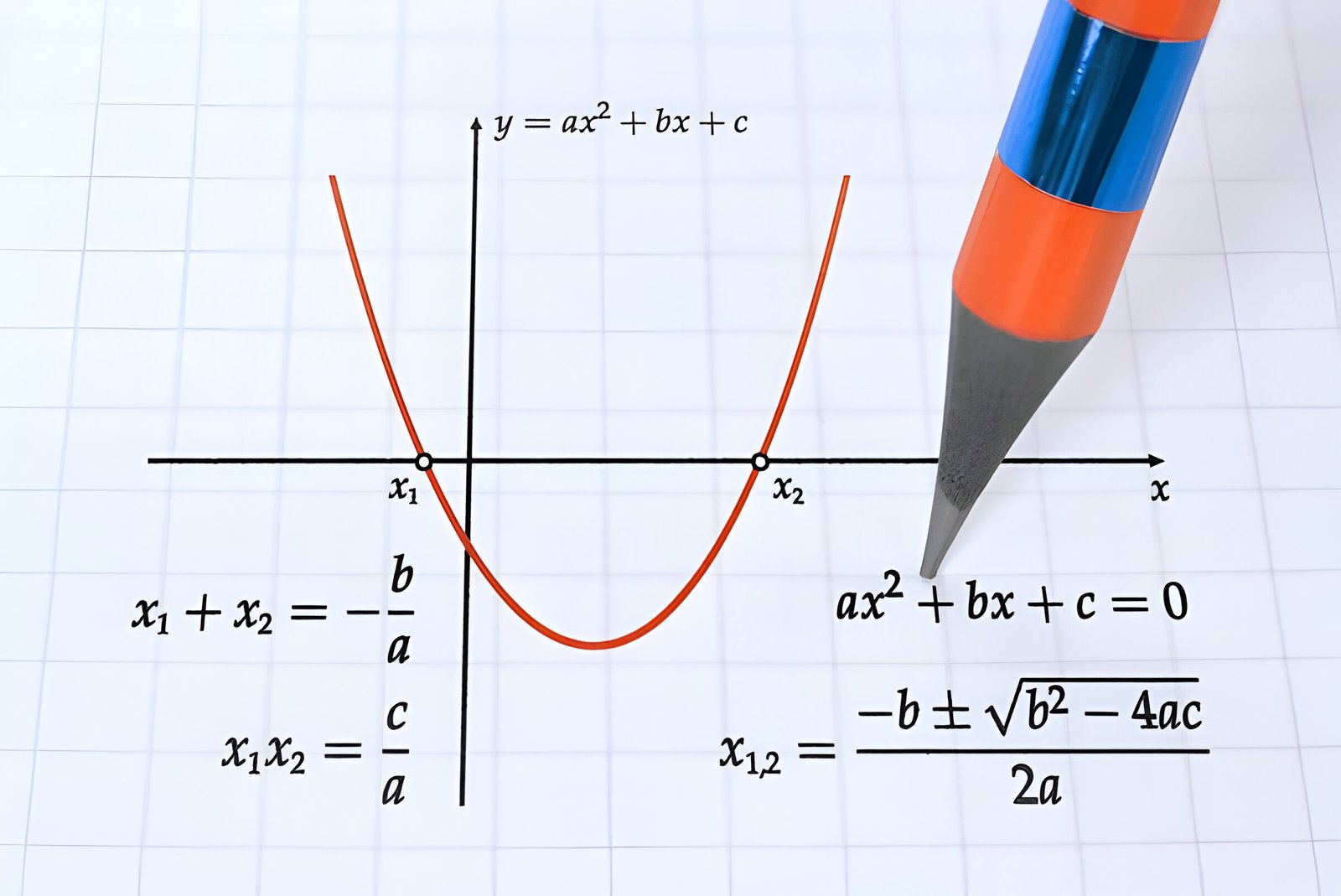Image Credit: Shutterstock
Quadratic functions are fundamental in mathematics, appearing in various real-world applications from physics to economics. Understanding how to find the vertex of a quadratic function is crucial for analyzing its behavior and solving related problems. This skill allows students and professionals to determine the highest or lowest point of a parabola, which has an impact on decision-making in fields like optimization and data analysis.
This guide will walk readers through different methods to find the vertex of a quadratic function. It will cover the basics of quadratic equations and their standard form, explain the vertex formula, and show how to complete the square. By the end of this article, readers will have a solid grasp of these techniques, enabling them to confidently tackle problems involving quadratic functions and their vertices.
ALSO READ:How to Tell if a Girl Likes You: Top 10 Signs to Watch
Table of Contents
ToggleUnderstanding Quadratic Functions and Vertices
Definition of a quadratic function
A quadratic function is a polynomial function of degree two, expressed in the form f(x) = ax² + bx + c, where a, b, and c are constants, and a ≠ 0. The graph of a quadratic function is called a parabola, which has a distinctive U-shape. These functions can open upward or downward, depending on the sign of the coefficient ‘a’. When ‘a’ is positive, the parabola opens upward, and when ‘a’ is negative, it opens downward.
Importance of the vertex
The vertex is a crucial point in a quadratic function. It represents the turning point of the parabola, where the function reaches its maximum or minimum value. For parabolas that open upward, the vertex is the lowest point (minimum), while for those that open downward, it’s the highest point (maximum). The vertex has an impact on various real-world applications, such as optimization problems in physics and economics.
Graphical representation of the vertex
On a graph, the vertex is the point where the parabola changes direction. It lies on the axis of symmetry, which is a vertical line that divides the parabola into two mirror-image halves. The coordinates of the vertex (h, k) provide valuable information about the function:
- The x-coordinate (h) indicates how far the parabola is shifted horizontally from the origin.
- The y-coordinate (k) shows the maximum or minimum value of the function.
To find the vertex, one can use the vertex form of a quadratic equation: f(x) = a(x – h)² + k. In this form, (h, k) directly represents the vertex coordinates. Alternatively, using the standard form (ax² + bx + c), the x-coordinate of the vertex can be calculated as -b/(2a), and the y-coordinate by plugging this x-value back into the original equation.
Understanding the vertex helps in analyzing the behavior of quadratic functions, solving related problems, and interpreting their graphs effectively. It has an impact on determining important characteristics such as the range of the function, its direction of opening, and its intercepts with the x-axis.
Using the Vertex Formula Method
The vertex formula explained
The vertex formula is a straightforward method to find the turning point of a quadratic function. For a quadratic equation in the standard form f(x) = ax² + bx + c, the x-coordinate of the vertex is given by x = -b/(2a). This formula stems from the vertex form of a quadratic equation, y = a(x – h)² + k, where (h, k) represents the vertex coordinates.
Step-by-step calculation process
To find the vertex using this method, follow these steps:
- Identify the coefficients: In the equation y = ax² + bx + c, determine the values of a, b, and c.
- Calculate the x-coordinate: Use the formula x = -b/(2a) to find the x-coordinate of the vertex.
- Find the y-coordinate: Substitute the x-coordinate back into the original equation to calculate the y-coordinate.
- Express the vertex as an ordered pair: Combine the x and y coordinates as (x, y).
For example, consider the equation y = 3x² – 6x + 1:
- Identify: a = 3, b = -6, c = 1
- Calculate x: x = -(-6) / (2 × 3) = 6 / 6 = 1
- Find y: y = 3(1)² – 6(1) + 1 = 3 – 6 + 1 = -2
- Express: The vertex is (1, -2)
Interpreting the results
The vertex coordinates provide valuable information about the quadratic function:
- The x-coordinate (h) indicates the axis of symmetry of the parabola.
- The y-coordinate (k) represents the maximum or minimum value of the function.
For upward-opening parabolas (a > 0), the vertex is the minimum point. For downward-opening parabolas (a < 0), it’s the maximum point. This information has an impact on analyzing the function’s behavior, including its range and direction of opening.
The vertex formula method is particularly useful when the quadratic equation is given in standard form. It provides a quick and efficient way to find the vertex without the need for graphing or completing the square, making it a valuable tool for students and professionals working with quadratic functions.
Finding the Vertex by Completing the Square
The concept of completing the square
Completing the square is a powerful method to find the vertex of a quadratic function. This technique transforms a quadratic equation from standard form (ax² + bx + c) into vertex form (a(x – h)² + k). The process involves manipulating the equation to create a perfect square trinomial, which reveals the coordinates of the vertex.
Detailed steps of the method
To complete the square and find the vertex, one can follow these steps:
- Ensure the coefficient of x² is 1. If not, factor it out.
- Move the constant term to the right side of the equation.
- Take half of the coefficient of x, square it, and add and subtract this value from both sides.
- Factor the left side into a perfect square trinomial.
- Simplify the right side.
- Express the equation in vertex form: a(x – h)² + k.
For example, given the equation x² + 6x + 5 = 0:
- Move the constant: x² + 6x = -5
- Half of 6 is 3, and 3² = 9: x² + 6x + 9 = -5 + 9
- Factor the left side: (x + 3)² = 4
- Take the square root: x + 3 = ±2
- Solve for x: x = -3 ± 2
The vertex is the point (-3, -4), where -3 is the x-coordinate (h) and -4 is the y-coordinate (k).
Advantages of this approach
Completing the square has several advantages:
- It provides a direct method to find the vertex without graphing.
- It helps in understanding the relationship between standard and vertex forms.
- The process reveals the axis of symmetry of the parabola.
- It has an impact on solving more complex equations and optimization problems.
This method has an impact on various fields, including physics and economics, where finding maximum or minimum values has practical applications. By mastering this technique, students and professionals can efficiently analyze quadratic functions and solve related problems with confidence.
Conclusion
Mastering the techniques to find the vertex of a quadratic function has a significant impact on problem-solving in mathematics and related fields. This guide has walked through different methods, including the vertex formula and completing the square, to equip readers with the tools to analyze parabolas effectively. These skills have an influence on various real-world applications, from optimization problems in economics to trajectory calculations in physics.
To wrap up, understanding how to find the vertex opens up new possibilities to interpret and use quadratic functions in practical scenarios. Whether you’re a student looking to ace your math exams or a professional aiming to apply these concepts in your work, these methods provide a strong foundation. As you practice and apply these techniques, you’ll find yourself becoming more confident in handling quadratic functions and their various applications.
ALSO READ: How to Tell if a Girl Likes You: Top 10 Signs to Watch
FAQs
1. How do you determine the vertex of a quadratic function using the vertex form?
To find the vertex of a quadratic function, you can use the vertex formula or convert the equation into vertex form. Start by calculating the x-coordinate of the vertex using x = -b/2a. Next, determine the y-coordinate by substituting this x-value back into the original quadratic equation f(x) = ax^2 + bx + c. Finally, use these coordinates (h, k) where h is the x-coordinate and k is the y-coordinate in the vertex form equation y = a(x – h)^2 + k.
2. What is the vertex formula for a quadratic equation?
The vertex formula helps locate the vertex of a parabola described by a quadratic equation. The coordinates of the vertex (h, k) can be calculated using (-b/2a, -D/4a), where D is the discriminant given by b^2 – 4ac.
3. How is the vertex of a parabola found?
To find the vertex of a parabola represented by the equation f(x) = ax^2 + bx + c, use the coordinates (-b/2a, f(-b/2a)). The axis of symmetry is at x = -b/2a. Alternatively, you can convert the standard quadratic form into the vertex form, f(x) = a(x – h)^2 + k, by completing the square, where (h, k) represents the vertex.
4. What does the step pattern refer to in the context of vertex form of a quadratic function?
The step pattern in vertex form refers to how the values of the quadratic function increase or decrease as you move away from the vertex along the x-axis. This pattern helps in graphing the quadratic function by showing the incremental changes on either side of the vertex.




